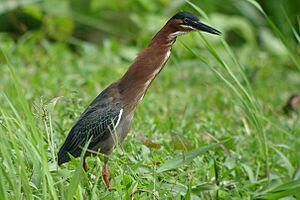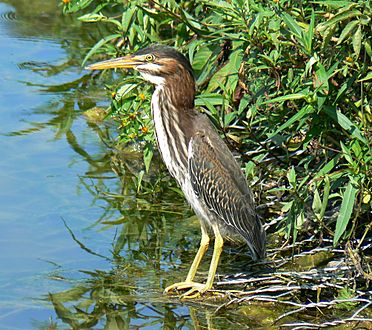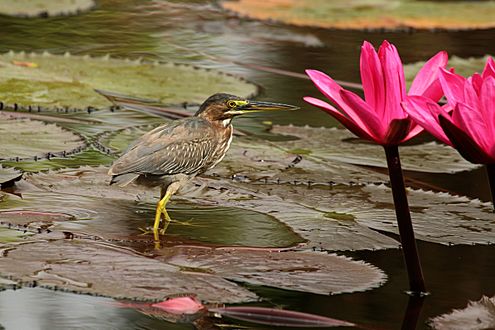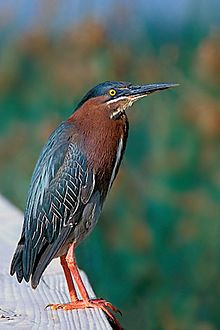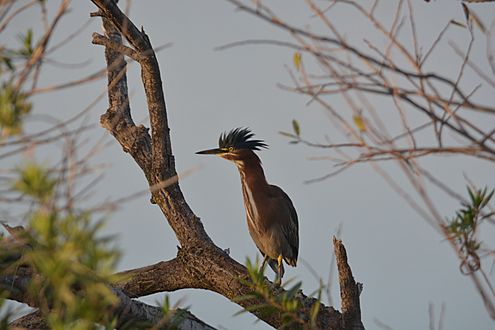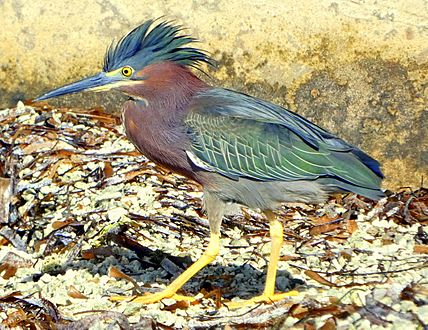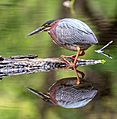Green heron facts for kids
Quick facts for kids Green heron |
|
|---|---|
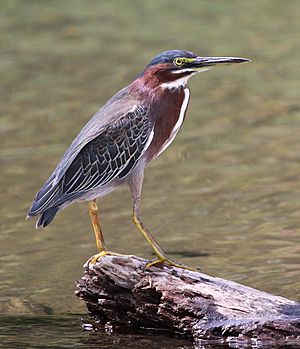 |
|
| Conservation status | |
| Scientific classification | |
| Genus: |
Butorides
|
| Species: |
virescens
|
 |
|
| Range of B. virescens Breeding range Year-round range Wintering range | |
| Synonyms | |
|
Ardea virescens Linnaeus, 1758 |
|
The green heron (Butorides virescens) is a small heron bird. It lives in North America and Central America. The name Butorides comes from words meaning "bittern" and "resembling". Virescens is a Latin word that means "greenish".
This bird was once thought to be the same species as the striated heron. Together, they were called the "green-backed heron." Green herons are very rarely seen in western Europe. For example, one was spotted in Wales in 2018. This was only the second time it had been seen there. Birds from the Pacific coast of North America can sometimes fly as far as Hawaii.
Contents
About the Green Heron
What Does a Green Heron Look Like?
The green heron is a fairly small bird. An adult is about 44 centimeters (17 inches) long. Its neck is often pulled in close to its body.
Adult green herons have a shiny, greenish-black cap on their heads. Their backs and wings are greenish-black or blue-grey. They have a reddish-brown neck with a white stripe down the front. Their undersides are grey, and their short legs are yellow. The bill is dark, long, and sharp.
Female green herons are usually smaller than males. Their feathers are also duller and lighter, especially during breeding season. Young green herons look different. Their heads, necks, and undersides are streaked with brown and white. Their backs and wing feathers have tan spots. Their legs and bills are greenish-yellow. Baby herons are covered in soft, light grey feathers on top and white feathers on their bellies.
Green Heron Sounds
The green heron makes a loud, sudden call that sounds like kyow. It also makes softer kuk calls.
During courtship, the male heron makes a raah-rahh sound with its bill wide open. It also makes noisy wingbeats and whoom-whoom-whoom calls when flying. Sometimes, it calls roo-roo to the female before landing. When sitting, it might make an aaroo-aaroo sound to attract a mate.
How Big Are They?
Here are some measurements for the green heron:
- Length: 41-46 cm (16.1-18.1 in)
- Weight: 240 g (8.5 oz)
- Wingspan: 64-68 cm (25.2-26.8 in)
Green Heron Family Tree
This species was once grouped with the B. striata heron. Scientists found fossil remains of an older heron, B. validipes, in Florida. This ancient bird might be an ancestor of the green heron.
It is hard to tell the different types (subspecies) of green herons apart. The color differences between groups are small. Birds that migrate (travel) have longer wings than those that stay in one place. This is because they fly more. More studies are needed to fully understand the different subspecies.
Here are some commonly listed subspecies, but their differences are still debated:
- Butorides virescens anthonyi (Mearns, 1895)
- These birds breed in the western United States. They go south to northern Baja California Peninsula, Mexico. Some stay there all year, but most fly to western Mexico in winter.
- Butorides virescens bahamensis (Brewster, 1888)
- These herons live in The Bahamas. They stay there all year.
- Butorides virescens frazari (Brewster, 1888)
- These birds live in the southern Baja California Peninsula, Mexico. They stay there all year.
- Butorides virescens maculata (Boddaert, 1783)
- These herons live from the southern United States through Central America to central Panama and the Caribbean. They stay there all year.
- Butorides virescens virescens (Linnaeus, 1758)
- These birds breed from southeastern Canada to the central and southern United States. They spend winter from the southernmost U.S. to northern South America.
Green Heron Life and Habits
Habitat and Diet
Green herons live in small wetlands in low areas. They are most active during dawn and dusk. They prefer to hide in sheltered spots during the day. However, they will hunt during the day if they are hungry or feeding their young. Herons living near the coast adjust their hunting to the ocean tides.
They mostly eat small fish, frogs, and water insects. But they will eat almost any small animal they can catch. This includes leeches and even mice. Green herons do not like other birds near them when they are eating. They do not hunt in groups.
They usually stand still on the shore or in shallow water. They also perch on branches and wait for prey. Sometimes, they drop food, insects, or other small things on the water. This attracts fish, which they then catch. This makes them one of the few animals known to use tools! This smart way of hunting has led some people to call them one of the world's most intelligent birds. They can even hover in the air for a short time to catch prey.
Migration and Breeding
Northern green herons fly to their breeding areas in March and April. In the farthest northern parts of their range, breeding starts by late May. They begin flying to their winter homes in September. By late October, they are gone from areas where they do not stay all year. It seems that global warming has not changed when they fly north. They arrive at their breeding grounds at the same time they did 100 years ago.
Herons that do not migrate leave their territories after breeding season. They wander around the area. They may or may not return to the same breeding spot next year. This depends on whether they found a better place during their travels. In these groups, the breeding season depends on how much rain there is and how much food is available.
Reproduction and Life Cycle
Green herons usually have one mate for a breeding season. Pairs form in the breeding area. The male heron chooses the nesting spot. He flies in front of the female, making noise and puffing up his head and neck feathers.
They build nests in forests and swamps, often over water or in plants near water. Nests are made of sticks, usually in shrubs or trees. Sometimes, they build nests on the ground. They prefer nests in trees, often several meters high. Rarely, many herons gather in large groups called heronries to nest.
A female usually lays 2 to 6 pale green eggs. She lays them every two days. After the last egg is laid, both parents sit on the eggs for about 19–21 days until they hatch. They both feed the young birds. The young birds start to leave the nest at 16 days old. But they cannot fully take care of themselves until they are 30–35 days old. Sometimes, especially in warmer areas, green herons breed twice a year.
Tool Use by Green Herons
Green herons are one of the few bird species known to use tools. They often use pieces of bread, insects, or other small items as bait. They drop the bait onto the water to attract fish. When a fish comes for the bait, the heron quickly catches and eats it.
If a green heron catches a large frog, it will drown the frog before swallowing it whole.
Gallery
- Green heron species account at Neotropical Birds (Cornell Lab of Ornithology)
Images for kids
See also
 In Spanish: Garcita verdosa para niños
In Spanish: Garcita verdosa para niños



